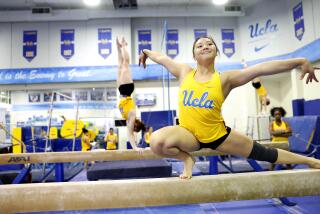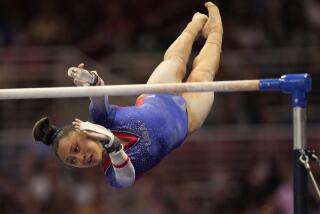Enjoy the Ride
TURIN, Italy — All the predictable emotions swept over Gretchen Bleiler that night.
Shock. Anger. Grief.
U.S. officials had just announced the snowboard team for the 2002 Olympic Games in Salt Lake City and Bleiler, tied for third in the qualifying contests, had missed the cut by way of a complex formula. To make matters worse, she got the news away from home, sitting in a hotel room.
“It all kind of hit me,” she says. “Really hard.”
It was a defining moment, the type of setback that can make a world-class athlete even more intense, training doubly hard, focusing on nothing but making the next Olympic team. Except Bleiler isn’t that kind of athlete.
No resentment tinges her words, no hint of vengeance in a schoolgirl’s smile framed by straight blond hair, a look that makes her seem younger than 24.
So when she finally gets her chance to stand atop the halfpipe here today as an Olympian — and blossoming media star — it will not be the result of a massive chip on her shoulder. If anything, that night four years ago made her want the Olympics a little less.
“These things happen for a reason,” she says. “They teach you different lessons.”
The Games had been a dream since she was a little girl watching on television. Not at all physically imposing — she has a body made for magazine covers, but more on that later — Bleiler nonetheless displayed athletic talent as a youngster, excelling in swimming, soccer and ice hockey.
A big part of her competitiveness came from having three brothers.
“We were always pushing each other, seeing how fast we could run down the stairs, doing sprint drills in front of the house,” she says. “I was always trying to do what they were doing.”
When Bleiler was 10, her mother moved the family from Ohio to Aspen, Colo. Soon, the brothers were snowboarding and Bleiler had found a sport that, as she puts it, “fit perfectly with my personality.”
She was good enough to join the U.S. team straight out of high school in 1999 and win the national halfpipe title two years later. As teammate Kelly Clark says, “She’s very determined . She knows where she wants to be and what it takes to get there.”
Everything seemed on schedule for Salt Lake City. Which turned out to be a problem.
In the months before the 2002 Games, all those years of dreaming, imagining what it might feel like, got to Bleiler.
“I wanted it so badly,” she recalled. “Because of that, I was so nervous that I wasn’t having fun and when I’m not having fun, I ride with hesitation.”
After shaky performances in the Olympic qualifiers, Bleiler found herself tied for the third and final spot on the team. The tiebreaker went to her friend, Tricia Byrnes. Bleiler went home. Flying into Aspen, she stopped to watch Clark win gold in the Olympic halfpipe finals on an airport television. An epiphany soon followed.
“To be so stressed out doesn’t make sense,” she says. “It’s snowboarding. It’s not brain surgery.”
Riding with a renewed sense of fun — no pressure, no hesitation — Bleiler dominated the next season, thanks in large part to the development of a maneuver known as a “crippler.”
In the world of halfpipe, where “spin to win” is the motto, the inverted whirling trick, combined with a daring 900-degree spin and a couple of 540s, separated her from the pack. And if this were a Hollywood script, she would have sailed along to Turin.
Things did not go that smoothly.
First came a detour by way of a phone call in the summer of 2003. The magazine FHM wanted to run a feature on her, so Bleiler flew to New York and did the interview, along with a provocative photo shoot in a bikini. A month later, the editors of the men’s magazine called to say the story had changed — now it was a cover piece on the girls of the Winter X Games.
Oh, by the way, they added, we’re going to shoot you in body paint.
As in nude, with the swimsuit painted on this time.
Recalling the moment, Bleiler ducks her head and giggles in a way that has a million marketing dollars written all over it.
“I’m definitely not the girl who loves prancing around in a bikini,” she says. “The day I was supposed to fly out, I was on the phone about to cancel.”
With boyfriend Chris Hotell, a former snowboarder, along for support, she went through with the shoot, even if it “pushed my boundaries and my comfort zone.”
The resulting magazine cover — she appeared beside another snowboarder, Tara Dakides, and sports commentator Jamie Little — jump-started Bleiler as a media darling.
“She’s perfect for it,” says Tracy Anderson, senior editor at Future Snowboarding magazine. “Beautiful. Smart. Speaks in complete sentences.”
But the increased hoopla, more interviews, more photo shoots, also had her feeling run down.
On a gray, snowy day in December 2003, while practicing for a slopestyle event at Breckenridge, Colo., she overshot a jump and suffered a torn knee ligament that required surgery. That, in turn, required “a ridiculous amount of time at the gym” and days spent hiking up Buttermilk Mountain near her condo in Aspen, taking the chairlift back down.
Another lesson learned. “I have to listen to my body,” she says. “I have to say no sometimes.”
Returning to competition in 2005, Bleiler hardly missed a beat, winning a World Cup event in Bardonecchia, — site of today’s Olympic halfpipe — and the made-for-television Winter X Games, second only to the Olympics in the hierarchy of snowboarding. This winter, four wins in five qualifying events left no doubt about a spot on the U.S. team.
All of which puts her in an enviable position. Along with Lindsey Jacobellis, a snowboard-cross racer, Bleiler is among the most-hyped female athletes of these Games. That blond hair and smile, a hipness figure skaters cannot deliver, all of it will be dangled before the young demographic that NBC and the International Olympic Committee crave.
Bleiler understands her role. She is part of a small group of riders who have separated from the U.S. skiing bureaucracy to form their own team, the Collection, signing deals with mainstream sponsors such as Snickers and Yamaha, traveling in a decked-out tour bus. Even after withdrawing from the recent Winter X Games to rest for Turin, she showed up one bone-chilling evening to sign autographs at a sponsor’s tent.
Snowboarding, she says, has given her more opportunities to make money than she ever imagined. But there remains the matter of performing in the crunch, adding to her arsenal. She has been working on the Michalchuk, an off-axis flip named after Canadian rider Mike Michalchuk, something no female boarder has pulled off.
“She’s clearly one of the best riders in the world,” U.S. halfpipe Coach Bud Keene says. “Her experience, her bag of tricks and the way that she puts it all together are certainly going to make her a contender.”
Anderson of Future Snowboarding goes a step farther: “This girl is going to take gold.”
That would be the accomplishment of a lifetime, a dream fulfilled, but Bleiler insists she won’t put too much pressure on herself. She learned her lesson in 2002 — the Olympics will not mean everything.
“Of course, it’s easier talking about this down here,” she says. “Once you get up to the top of the pipe, things sort of change and you get nervous.”
The last year or so, she has developed techniques to stay calm before her runs. Sometimes that means lying on the snow and closing her eyes, taking deep breaths. Other times, she looks over the fans lining the halfpipe, “just realizing how lucky I am,” she says.
Enjoy this, she tells herself.Don’t stress out.
More to Read
Get our high school sports newsletter
Prep Rally is devoted to the SoCal high school sports experience, bringing you scores, stories and a behind-the-scenes look at what makes prep sports so popular.
You may occasionally receive promotional content from the Los Angeles Times.







